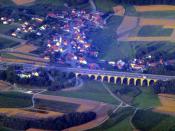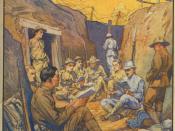Nature of Trench Warfare
Temporary
Just for the cold winter of 1914
The G trenches were more sophisticated and officers lived in better conditions - the G saw the possibility of the trench system of fighting possibly becoming more permanent
The Trenches:
*Were 4 feet deep with a built - up wall of sandbags to form a parapet at the front and a parado at the back. This added extra height, support for the trenches, and excess mud and dirt to be placed.
*Along the sides of trenches there were holes known as dugouts, there were created to allow space for soldiers to lie down. Some had rooms lined with boards, bunks and electric lighting.
*They had firing steps and elbow rests to ensure better shooting.
*Duckboards allowed soldiers to stand out of the mud in the bottom of the trenches.
*Towards no mans land, bared wire was stretched to slow down enemy attack.
Unfortunately, this had to be taken down at nigh got their own attack, which eliminated the element of surprise.
*Were constructed in a zigzag pattern called 'firebays' or 'traverses' 5m's apart so that if the enemy got in shrapnel would hit walls not people, bullets would hit walls not people as well.
Life in the trenches
*3 out of every 4 weeks was spent in rest or in the reserve trenches
During rest dug new trenches, filled sandbags, walked approximately 16km's a day, secured trench walls, collected their pay, washed thoroughly, prepared the nights meal, Helped transport ammunition.
Discomforts
*Fatigue: Early mornings - 'stand to' half an hour before daylight ad trench line activity such as maintenance in dangerous positions were carried out at night.
*Much time watching and waiting in anxiety/boredom.
*Sight, stench and sounds of the dead and wounded.
*Sounds of bombs and shells...


